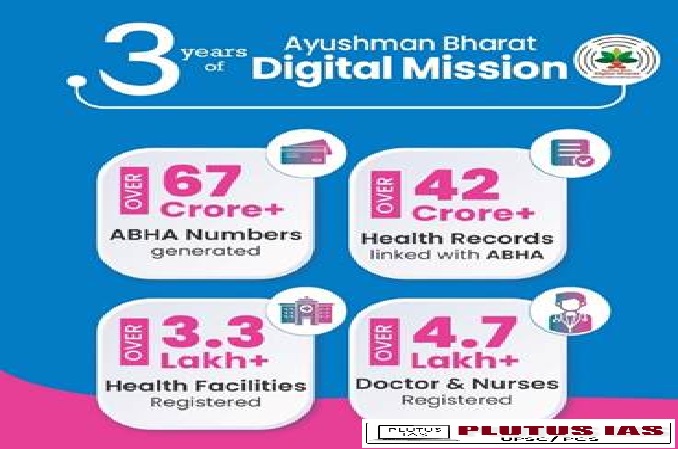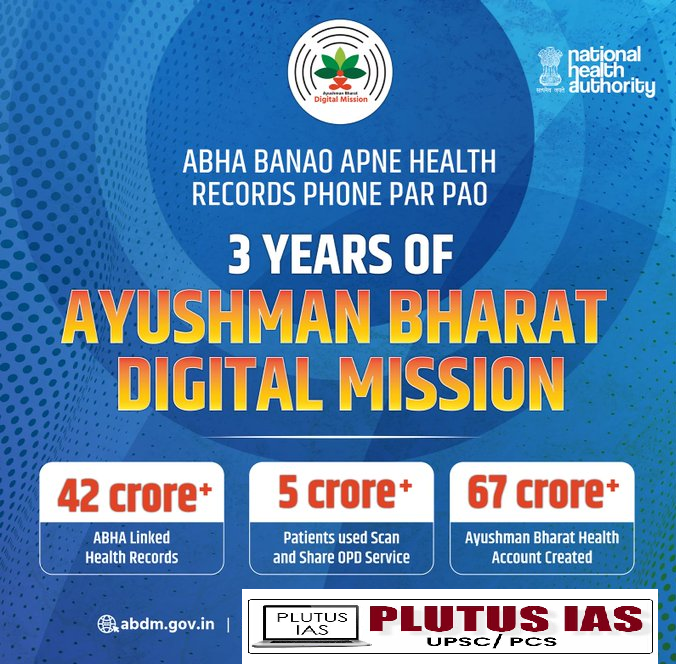28 Sep Over 67 crore Ayushman Bharat Health Accounts created under Ayushman Bharat Digital
SYLLABUS MAPPING:
GS-2-Health, Government Policies and interventions–Over 67 crore Ayushman Bharat Health Accounts created under Ayushman Bharat Digital
FOR PRELIMS:
Evaluate the challenges of implementing the Ayushman Bharat Digital Mission in the context of India’s diverse socio-economic landscape.
FOR MAINS:
RECENT CONTEXT:
The Ayushman Bharat Digital Mission (ABDM) has recently made headlines for achieving a landmark milestone: the creation of over 67 crore Ayushman Bharat Health Accounts (ABHA). This achievement marks a significant step forward in India’s healthcare landscape, leveraging digital technology to enhance accessibility, efficiency, and quality of care. As the nation continues to grapple with healthcare challenges, the ABDM is positioned as a crucial initiative to bridge the gap between citizens and healthcare services, particularly for the underserved and marginalized populations.
The surge in health account registrations showcases not only the government’s commitment to digital transformation but also the increasing awareness and acceptance of technology in managing health records. The mission aims to empower individuals by providing them with control over their health data, thereby fostering a more informed and proactive approach to health management.
Government Initiative:
Launched in September 2020, the Ayushman Bharat Digital Mission is a flagship initiative of the Indian government under the broader Ayushman Bharat scheme, which aims to provide comprehensive healthcare services to all citizens. The initiative is designed to create a national digital health ecosystem, enhancing the integration of health services and promoting universal health coverage across India.
The ABDM focuses on the digitalization of health records, ensuring that individuals have access to their medical history, lab reports, and treatment information through a single digital platform. This mission is particularly relevant in a country like India, where healthcare accessibility and quality remain major challenges.
Objectives of the Ayushman Bharat Digital Mission:
1.Creating a Digital Health Infrastructure: Establish a robust digital health infrastructure to facilitate the integration and sharing of health data among various stakeholders.
1.Enhancing Accessibility: Improve access to healthcare services for all citizens, especially those in remote and underserved areas, by leveraging digital tools.
2.Empowering Citizens: Enable individuals to access and manage their health information securely, promoting informed decision-making regarding their health.
3.Streamlining Health Services: Enhance the efficiency of healthcare delivery through better coordination and communication among healthcare providers.
4.Promoting Research and Innovation: Use the data generated through the digital health system for research, policy-making, and improving health outcomes.

Key Features of the Ayushman Bharat Digital Mission:
1. Ayushman Bharat Health Accounts (ABHA)
At the heart of ABDM is the Ayushman Bharat Health Account (ABHA), a unique identification number assigned to individuals. The ABHA serves as a digital repository for personal health records, enabling individuals to store and manage their medical history securely. This feature facilitates easier access to health information during consultations, improving the continuity of care.
2. Digital Health ID
Each citizen can create a Digital Health ID linked to their ABHA, which helps in maintaining a comprehensive health record. This Digital Health ID ensures that healthcare providers have access to relevant patient information, aiding in accurate diagnoses and treatment plans.
3. Interoperability
The mission emphasizes interoperability among various healthcare systems, enabling seamless data sharing between different stakeholders. This integration is crucial for improving patient outcomes and ensuring that healthcare providers have the necessary information for informed decision-making.
4. Telemedicine Services
ABDM promotes telemedicine, which allows patients to consult healthcare providers remotely. This service is particularly beneficial for individuals in rural and remote areas, where access to healthcare facilities may be limited.
5. Health Registries
ABDM establishes health registries for healthcare professionals and institutions, allowing for better tracking and monitoring of healthcare services. These registries also aid in research and policy formulation, providing valuable data for improving healthcare delivery.
Significance of the Ayushman Bharat Digital Mission:
1. Universal Health Coverage
By facilitating the digitalization of health records, ABDM aims to ensure that every citizen has access to essential health services. This is particularly important in a country with a vast population and significant disparities in healthcare access.
2. Improved Health Outcomes
The ability to access comprehensive health information can lead to better health outcomes. Patients can receive timely interventions, and healthcare providers can make informed decisions based on accurate data.
3. Economic Efficiency
The digital transformation of healthcare can lead to substantial cost savings by reducing paperwork, minimizing administrative burdens, and streamlining processes. This efficiency can free up resources for other critical areas of healthcare.
4. Empowering Patients
ABHA empowers individuals by giving them control over their health data. This transparency fosters a more informed patient population, encouraging active participation in their health management.
Challenges Facing the Ayushman Bharat Digital Mission:
1. Digital Divide
A significant portion of India’s population, particularly in rural areas, lacks access to the internet and digital devices. This digital divide can exclude many potential beneficiaries from the advantages offered by ABDM.
2. Data Security and Privacy
The digitization of health records raises concerns about data breaches and unauthorized access to sensitive information. Ensuring robust cybersecurity measures is essential for maintaining public trust.
3. Lack of Digital Literacy
Many citizens and healthcare providers may not possess the necessary skills to navigate digital health tools effectively. This gap in digital literacy could limit the adoption and utilization of ABDM services.
4. Integration with Existing Systems
Integrating ABDM with existing healthcare infrastructures can be complex and resource-intensive. Achieving interoperability among various systems requires substantial investment and collaboration.
5. Financial Constraints
Funding for the necessary technological infrastructure and training programs can pose challenges, particularly in underserved regions where healthcare budgets are already strained.
Way Forward:
1. Bridging the Digital Divide
Initiatives aimed at improving internet connectivity and access to digital devices in rural and underserved areas are crucial. Collaborations with private sector players can help extend reach and provide necessary resources.
2. Strengthening Data Security
Implementing robust cybersecurity protocols and adhering to strict privacy policies can enhance the security of health records and foster trust among users.
3. Fostering Digital Literacy
Comprehensive training programs for both healthcare providers and patients should be established to improve digital literacy. Educational campaigns can raise awareness about the benefits of digital health tools, encouraging adoption and effective use.
4. Ensuring Seamless Integration
Developing a clear framework for integrating ABDM with existing health systems can facilitate smoother implementation and interoperability among various stakeholders. Engaging with healthcare institutions and technology providers is essential.
5. Securing Sustainable Funding
Adequate financial resources must be allocated for the development and maintenance of the digital health infrastructure. Engaging with international organizations, non-governmental entities, and private sector partners can provide additional funding avenues.
Conclusion:
The Ayushman Bharat Digital Mission represents a transformational step toward modernizing India’s healthcare system through digital innovation. The creation of over 67 crore Ayushman Bharat Health Accounts is a significant milestone that reflects the government’s commitment to enhancing healthcare access and quality. However, addressing challenges such as the digital divide, data privacy concerns, and the need for digital literacy will be critical for its success. By adopting a proactive and inclusive approach, ABDM can revolutionize healthcare delivery in India, empower citizens, and set a global example for leveraging technology in public health. As India progresses toward a more digitally enabled healthcare landscape, the Ayushman Bharat Digital Mission has the potential to be a cornerstone in achieving universal health coverage and improved health outcomes for all.

Download plutus ias current affairs eng med 28th Sep 2024
Q. What is the primary purpose of the Ayushman Bharat Health Accounts (ABHA) under the Ayushman Bharat Digital Mission?
A. To replace traditional health insurance schemes
B. To provide a digital repository for personal health records
C. To facilitate medical tourism
D. To standardize healthcare costs across India
ANSWER:B




No Comments